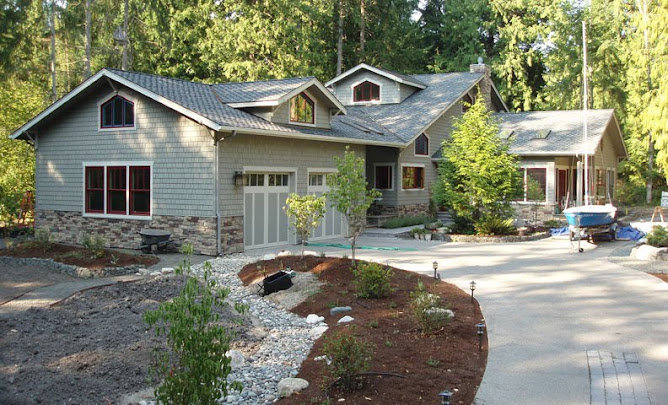 Anyway, over the past few years we'd stop by and chat with Susie, who manages the front end of the shop. She does all the layout for the slabs, and John does the cutting and fabrication. On Monday we went over to see our 2 slabs of Verde Vermont Antique. John had selected two for us and brought them over to Sequim along with a dozen other slabs for current customers. They looked just as good as in Seattle, but my photos aren't great due to reflections from the polished surface of the rock.
Anyway, over the past few years we'd stop by and chat with Susie, who manages the front end of the shop. She does all the layout for the slabs, and John does the cutting and fabrication. On Monday we went over to see our 2 slabs of Verde Vermont Antique. John had selected two for us and brought them over to Sequim along with a dozen other slabs for current customers. They looked just as good as in Seattle, but my photos aren't great due to reflections from the polished surface of the rock.The company that markets this material isn't doing themselves any favors by calling it Serpentine (or green) Marble. Marble, as you may know, is a low grade metamorphic rock almost always composed primarily of calcium carbonate (calcite). One of calcite's (and thus marble's) interesting traits is that it is soluble in acid. Now who would ever put acid on a counter top you say: Try vinegar, lemon, tomato, wine, coca cola, etc. All in the 2-4 pH range. Each will etch the surface and leave a visible ring, which cannot be removed.

So we literally did the acid test on the Verde Vermont Antique. White wine (pH 3) and a slice of lemon (pH 2.3) overnight on a sample we got from Michaelangelos. Sat overnight, then I wiped the mess up in the morning. Both left a slightly darker spot, but no etching of the polished surface. The dark spot disappeared as the rock dried, so that was a surface effect. In our minds, the rock passed the ACID TEST. So in reality, the Verde Vermont Antique should be marketed as Serpentinite, but that's not nearly as intriguing a name. Here is a little blurb on the geology of Verde Vermont Antique for my geology friends (from www.vtverde.com). The quarry is located about 2 miles north of Rochester, VT, on the eastern margin of the Green Mountains.
 Vermont Verde Antique while having the “look” of marble is a serpentine and classified as a hydrous magnesium silicate. With the hardness and durability of most granite and its low absorption rate and high flexural strength, it is an excellent choice for both interior and exterior uses. Vermont Verde Antique is the commercial name for the serpentine “marble” derived from highly sheared ultramafic rocks that have been rewelded and metasomatized by the process of serpentinization. Numerous lense-shaped serpentinite bodies of varying size occur along the spine of the Green Mountains, west of the Adirondacks. The ultramafic bodies, once thought to be of igneous intrusive origin, are now recognized as segments of ancient oceanic crust that became part of the eastern North American continent during the Taconian orogeny. This is considered to be middle Ordovician in age, around 450 million years ago. More deformation and metamorphism took place during the Acadian orogeny around 360 million years ago. This may have resulted in the polishable Vermont Verde Antique serpentine.
Vermont Verde Antique while having the “look” of marble is a serpentine and classified as a hydrous magnesium silicate. With the hardness and durability of most granite and its low absorption rate and high flexural strength, it is an excellent choice for both interior and exterior uses. Vermont Verde Antique is the commercial name for the serpentine “marble” derived from highly sheared ultramafic rocks that have been rewelded and metasomatized by the process of serpentinization. Numerous lense-shaped serpentinite bodies of varying size occur along the spine of the Green Mountains, west of the Adirondacks. The ultramafic bodies, once thought to be of igneous intrusive origin, are now recognized as segments of ancient oceanic crust that became part of the eastern North American continent during the Taconian orogeny. This is considered to be middle Ordovician in age, around 450 million years ago. More deformation and metamorphism took place during the Acadian orogeny around 360 million years ago. This may have resulted in the polishable Vermont Verde Antique serpentine.














